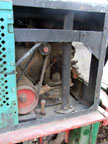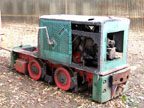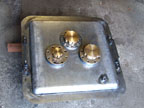 _
_
November 2009
Everybody knows that's not so good to
start an old motor that hasn't been running for long time. It
is better to dismantle it completely, check all parts, change
or repair some and assemble the motor. But this procedure needs
time and the curiosity is stronger than patience and carefulness.
Therefore only a few maintenance work had to be enough before
the LD2 run again after years by its own power. After the
fixed exhaust valve gave up its resistance by some quite strong
hammer blows, the valves get grinded, they have flat (no conical)
seats. Further still the rust at piston head and cylinder head
was eliminated and the decompression arrangement was made passable.
After filling up warmed cooling water the loco was ready for run.
It was an illusion to start the motor only by crank, so the loco
was dragged by another one and someone turned the crank too. The
engine exhausts marvelous, dark grey-brown clouds and has an impressing
sound. If the adjusted number of revolutions is reached, it runs
quite cleanly. Nevertheless there's still enough work remaning
for later time. _
_
October 2009
By the hint of a friend a locomotive joined
the collection, which fullfilled a long time desire: a LD2
from O&K Montania. And it is not an "ordinary" loco
of this type, it's in mining design, from which only three existing
locomotives are known. The LD2 served in the past in a tourism
park and that to see clearly in the subsequent additions like
the cab, the framework widening and the auxiliary buffers. However
all can be removed without problems. In order to have again a
correct mining loco, only a new exhaust gas scrubber box is to
built and to connect with the exhaust gas pipe. The right colour
for framework and wheels will be black and for the bonnet "O&K-green".
The total condition of the machine is good, even though it remained
some years outdoors. _
_ _
_ _
_
After dismounting the parts mentioned before, the
locomotive already lookes quite similar to its original appearance.
The very compact design is remarkable, in order to achieve the
small clearance demanded for the pit use. Even though the engine
driver had the luxury of a pedal for speed control, nevertheless
he was little to envy: its seat was the tool box and the its cab
was very small. A first check showed that the flywheel is turnable
but there is water in the exaust pipe, not a good sign. Now it
needs to dismount the cylinder had for getting more information. _
_ _
_
Fortunately the piston was in the
upper, so the water could not cause larger damage. Piston head
and cylinder head were tidy rusty, but they could be furbished
up with justifiable effort. The inside of the sleeve is in a condition,
which lets a test run appear possible. More problems might make
the main bearing of the crankshaft. The cylinder head gasket looks
still very good. On closer inspection of the area under the hood
the former place of the compressed air bottle for the start facility
was to found. At longer term there's the goal add the parts of
this facility. _
_ _
_ _
_
April 2009
With the help of friendly metalworkers
the tank of the benzene loco could be rebuilt under use
of the existing fittings. The bodyshell work is finished.
The present tank wasn't furtheron useable. That was clearly to
see after sandblasting. It was mounted in the upper side of the
bonnet and totally corroded by mine waters. Now the special screws
for the mounting of the fittings are to buy. The brass nipples
are very massive and adapted to the rough operatings in a pit. _
_
January 2009
The next step is done: the cylinder liner
of the L180 is pulled out! Because of the large contact
area and the long lasting immobilisation time the liner was stuck
together with the cylinder cover. Even four cuts for relaese didn't
achieve success. A sledge hammer and two elevating screws were
required to bring the liner out.  _
_ _
_